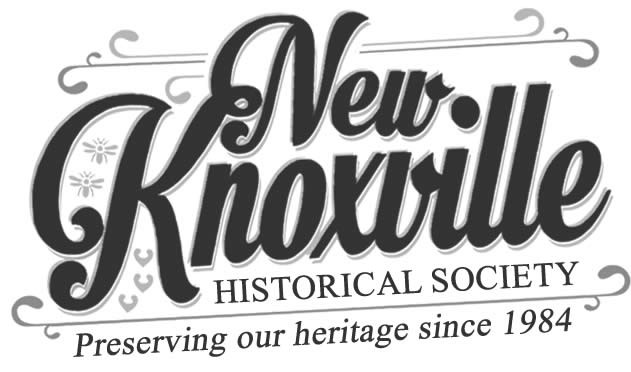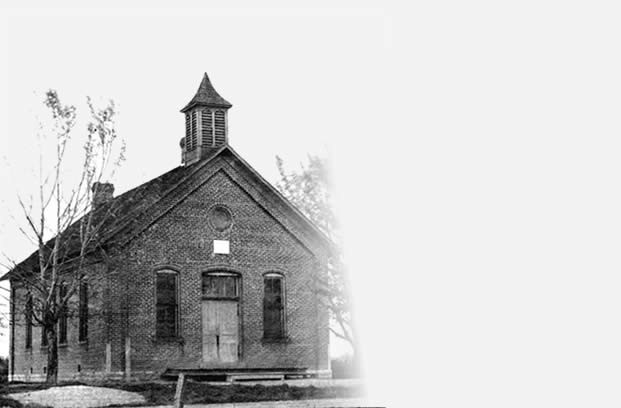In 1993 the Methodist congregation of New Knoxville celebrated the 150th anniversary of their founding. Members, former pastors and friends of the congregation were asked to submit stories of their memories of worshiping and participating in the various activities of the congregation. These memories were published in their Sesquicentennial souvenir booklet. The writings of Arnold and Martha Meckstroth told of the history of their families and the participation of their ancestors in the founding of the Methodist Church in New Knoxville. For Norman Katterheinrich (1912-2003), the demolition of the old church building in 1916 and the building of the new church was a childhood memory. Alice Kuck remembered the old heating stove in the sanctuary and the barns behind the church.
Submitted by Arnold Meckstroth
My great grandfather, Gerhardt Wilhelm Meckstroth, the first “Meckstroth,” who with his younger brother, Herman Heinrich Jr. migrated to New Knoxville from Ladbergen, Prussia (Germany) in 1834. They both became founding members of the Methodist Church in 1843. Earlier, in 1838, they were members of the founding group of the Reformed Church in New Knoxville.
This was the beginning of a part of the early Meckstroth family to become identified with the Methodist Church and this heritage is precious and dear to me. Gehardt Wilhelm died in 1886 and is buried in the old Methodist Cemetery in New Knoxville. In the 1850’s, Herman Heinrich Jr. moved with his family to Le Sueur, Minnesota and there were active members in the Methodist Church.
Gerhardt Wilhelm’s family included a son, William George, my grandfather, who with his large family have been members of the Methodist Church. One of the family of William George was my father, Benjamin Lewis, who was a member of the Methodist Church until his marriage to my mother, Anna Marie Maneke, in 1893.
Although being reared in the Reformed Church, (now the United Church of Christ), I recall our attendance at the night services in the Methodist Church when I was a child and the worship was in the old church building which was replaced by the present church building in 1916. I also recall frequent attendance in my growing years in the present church building.
One of my special memories is that I remember my grandparents, William George and his wife Elizabeth, nee Fledderjohann, as faithful members of the Methodist Church and I recall with appreciation their 50th wedding anniversary celebration in 1918 and later their funeral services in the church.
They have left for me, with my parents, a heritage that is sacred. I am grateful.
Submitted by Martha E. (Katterheinrich) Meckstroth
The first eleven years (1909-1920) of my life were spent in the New Knoxville area and in the Methodist Church. I remember well going to Sunday School and Church. Mrs. Fannie Slack was my Sunday School teacher. I especially remember the Christmas programs which the children and young people gave in the old Church. My parents were William and Mary Lagemann Katterheinrich who were faithful members of the church.
My great grandfather, John Heinrich W. Katterheinrich, came from Ladbegen, Prussia (Germany) to New Knoxville and helped to organize the Methodist Church. He was a “Class Leader” of the Sunday School and a Local Preacher. He, with others, provided land for a parsonage. He is buried in the old Methodist Cemetery.
My grandparents were Adolph Solomon and Elizabeth Eisley Katterheinrich. My grandfather Katterheinrich died before 1900 and later my grandmother married Henry Lutterbeck who was a member of the Reformed Church. He remained faithful to his church and my grandmother to the Methodist Church.
Through the years, the Katterheinrich family has given of their talents and efforts to the Methodist Church, especially my uncle, Elmer Katterheinrich. His daughter-in-law, Shirley Katterheinrich, is a member of the church.
My Lagemann grandparents were Heinrich and Fredericka Hoge Lagemann. They came to the United States from Ladbergen, Prussia (Germany), in the 1860’s to Cincinnati, Ohio. They did not come together; they met later in Cincinnati and were married. They came to the New Knoxville community in the 1890’s and after a few years became members of the Methodist Church.
My aunt, Elizabeth Lagemann Schanzlin, was a missionary in India, having gone there with her husband, Gottlieb Schanzlin, in 1912. Elizabeth died there in 1918 before it was time for their first furlough back to the states. She is buried in Calcutta, India. My uncle, Theodore Lagemann became a Methodist minister. He was a graduate of Baldwin Wallace College and Seminary, Berea, Ohio. He died in 1937.
Having served churches in Ohio, Indiana, and Michigan.
It was in 1920 that our family moved to St. Marys, after our home, which was on Washington Pike, was destroyed by a tornado on Palm Sunday night, March 28, 1920. This was the day when my sister, Mabel Katterheinrich Kattman, was confirmed in the church. Soon after moving to St. Marys, our family joined the Wayne Street Methodist Church.
The memories of having been in the New Knoxville Methodist Church are still very vivid in my mind and I enjoy attending the services from time to time, and always think of my parents, grandparents, and many of the relatives and friends who are no longer here. There are still three of my Katterheinrich cousins in the congregation; Ruth Kuck, Olga Stienecker and Norman Katterheinrich. There are no longer any Lagemann descendants who are members in the congregation.
My hope and wish too is that the United Methodist Church in New Knoxville will continue to carry out her mission and ministry in the community and beyond.
Submitted by Norman Katterheinrich
I remember when the tower of the old Methodist Church was taken down before they built the new church that is now in its place. I was at the Henry Eversman home that was standing where the barn is now located, across the street from the church. I wanted to watch through the window, and when it was to come down, someone shut the shutter to save the window, so I didn’t get to see it fall.
While the new church was being built we had a Christmas program on the second story of the old Town Hall. After the basement of the new church was finished, we had Sunday School and church in the basement while the rest of the church was being built.
Submitted by Alice Kuck
Alice remembers back before the efficient heating system was installed in the church. There was a stove in the sanctuary. People sitting near the stove came away from the service red faced from the heat, while people sitting away from the stove came away from the service very cold.
She also remembers the barns that were located behind the church. People used to ride to the church in their horse-pulled buggies. The horses were hitched outside or taken to the barns while the families attended worship.


